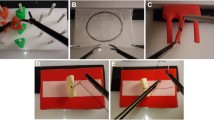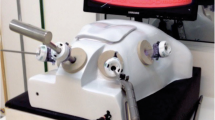Abstract
Introduction
Laparoscopic basic skills are best trained in the nonclinical setting. Box trainers and virtual-reality trainers have been shown to be useful in training laparoscopic skills. Certain nonsurgical skills may predict baseline skills in these trainers. This study tested the hypothesis that baseline scores could be predicted in inanimate box trainers and virtual-reality trainers by nonsurgical skills.
Methods
Only preclinical medical students were included in the study. All students were given a survey ascertaining if they played computer games, typed, sew, played a musical instrument, and utilized chopsticks. Students utilized a box trainer (BT) and/or virtual-reality trainer (VR). Nonparametric two-tailed Mann–Whitney tests were utilized to compare students that possessed certain nonsurgical skills versus those who did not.
Results
There were 18 students in the VR group and 33 students in the BT group. In the VR group, students who played computer games, typed, utilized chopsticks, or played a musical instrument had better scores and fewer errors than those who did not but this did not reach statistical significance in any comparison (p = NS). In the BT group, none of the nonsurgical skills predicted times or errors. Males performed better than females in the VR group (p < 0.001); but this gender discrepancy was not seen in the BT group.
Conclusions
Nonsurgical skills do not predict baseline scores in either trainer. The gender differences in VR training need to be further explored.
Similar content being viewed by others
References
Accreditation Council for Graduate Medical Education. http://www.acgme.org/acWebsite/RRC_440/440_minReqLaparoscopy.asp. Feb 1, 2006
Madan AK, Frantzides CT, Tebbit CL, Park WC, Kumari NVA, Shervin N (2004) Evaluation of specialized laparoscopic suturing and tying devices. JSLS 8:191–193
Madan AK, Frantzides CT, Shervin N, Tebbit CL (2003) Assessment of individual hand performance in box trainers compared to virtual reality trainers. Am Surg 69:1112–1114
Gallagher AG, McClure N, McGuigan J, Crothers I, Browning J (1999) Virtual reality training in laparoscopic surgery: A preliminary assessment of minimally invasive surgical trainer reality (MIST VR). Endoscopy 31:310–313
Madan AK, Frantzides CT (2007) Prospective, randomized controlled trial of laparoscopic trainers in laparoscopic skills acquisition. Surg Endosc 21(2):209–213
Ali MR, Mowery Y, Kaplan B, DeMaria EJ (2002) Training the novice in laparoscopy. Surg Endosc 16:1732–1736
Champion JK, Hunter J, Trus T, Laycock W (1996) Teaching basic video skills as an aid in laparoscopic suturing. Surg Endosc 10(1):23–25
Figert PL, Park AE, Witzke DB, Schwartz RW (2001) Transfer of training in acquiring laparoscopic skills. J Am Coll Surg 193:533–537
Harold KL, Matthews BD, Backus CL, Pratt BL, Heniford BT (2002) Prospective randomized evaluation of surgical resident proficiency with laparoscopic suturing after course instruction. Surg Endosc 16:1729–1731
Pearson AM, Gallagher AG, Rosser JC, Satava RM (2002) Evaluation of structured and quantitative training methods for teaching intracorporeal knot tying. Surg Endosc 16:130–137
Rosser JC, Murayama M, Gabriel NH (2000) Minimally invasive surgical training solutions for the twenty-first century. Surg Clin North Am 80(5):1607–1624
Rosser JC, Rosser LE, Savalgi RS (1997) Skill acquisition and assessment for laparoscopic surgery. Arch Surg 132:200–204
Seymour NE, Gallagher AG, Roman SA, O’Brien MK, Bansal VK, Andersen DK, Satava RM (2002) Virtual reality training improves operating room performance: Results of a randomized, double-blinded study. Ann Surg 238(4):458–464
Hasson HM, Kumari NV, Eekhout J (2001) Training simulator for developing laparoscopic skills. JSLS 5:255–265
Madan AK, Frantzides CT, Tebbit C, Shervin N (2005) Self-reported vs observed scores in laparoscopic skills training. Surg Endosc 19:670–672
Madan AK, Frantzides CT, Park WC, Tebbit CL, Kumari NVA, O’Leary PJ (2005) Predicting baseline laparoscopic surgery skills. Surg Endosc 19(1):101–103
Grantcharov TP BL, Funch-Jensen P, Rosenberg J (2003) Impact of hand dominance, gender, and experience with computer games on performance in virtual reality laparoscopy. Surg Endosc 17:1082–1085
Rosenberg BH, Landsittel D, Averch TD (2005) Can video games be used to predict or improve laparoscopic skills? J Endourol 19(3):372–376
Rosser JC Jr, Lynch PJ, Cuddihy L, Gentile DA, Klonsky J, Merrell R (2007) The impact of video games on training surgeons in the 21st century. Arch Surg 142(2):181–186
Tsai CL, Heinrichs WL (1994) Acquisition of eye-hand coordination skills for videoendoscopic surgery. J Am Assoc Gynecol Laparosc 1(4, pt 2):S37
Madan AK, Frantzides CT, Tebbit C, Quiros RM (2005) Participants’ opinions of laparoscopic training devices after a basic laparoscopic training course. Am J Surg 189:758–761
Madan AK, Frantzides CT (2007) Substituting virtual reality trainers for inanimate box trainers does not decrease laparoscopic skill acquisition. JSLS 11(1):87–89
Madan AK, Frantzides CT, Sasso LM (2005) Laparoscopic baseline ability assessment by virtual reality. J Laparoendosc Adv Surg Tech A 15(1):13–17
Ritter EM, D A McClusky III, Gallagher AG, Enochsson L, Smith CD (2006) Perceptual, visuospatial, and psychomotor abilities correlate with duration of training required on a virtual-reality flexible endoscopy simulator. Am J Surg 192:379–384
Swanstrom LL, Fried GM, Hoffman KI, Soper NJ (2006) Beta test results of a new system assessing competence in laparoscopic surgery. J Am Coll Surg 202(1):62–69
Vassiliou MC, Ghitulescu GA, Feldman LS, Stanbridge D, Leffondre K, Sigman HH, Fried GM (2006) The MISTELS program to measure technical skill in laparoscopic surgery. Surg Endosc 20:744–747
Kimura T, Kawabe A, Suzuki K, Wada H (2006) Usefulness of a virtual reality simulator or training box for endoscopic surgery training. Surg Endosc 20:656–659
Acknowledgements
The authors would like to acknowledge the technical assistance of Mrs. Courtney Bishop in the preparation of this manuscript.
Author information
Authors and Affiliations
Corresponding author
Rights and permissions
About this article
Cite this article
Madan, A.K., Harper, J.L., Frantzides, C.T. et al. Nonsurgical skills do not predict baseline scores in inanimate box or virtual-reality trainers. Surg Endosc 22, 1686–1689 (2008). https://doi.org/10.1007/s00464-007-9691-0
Received:
Revised:
Accepted:
Published:
Issue Date:
DOI: https://doi.org/10.1007/s00464-007-9691-0




